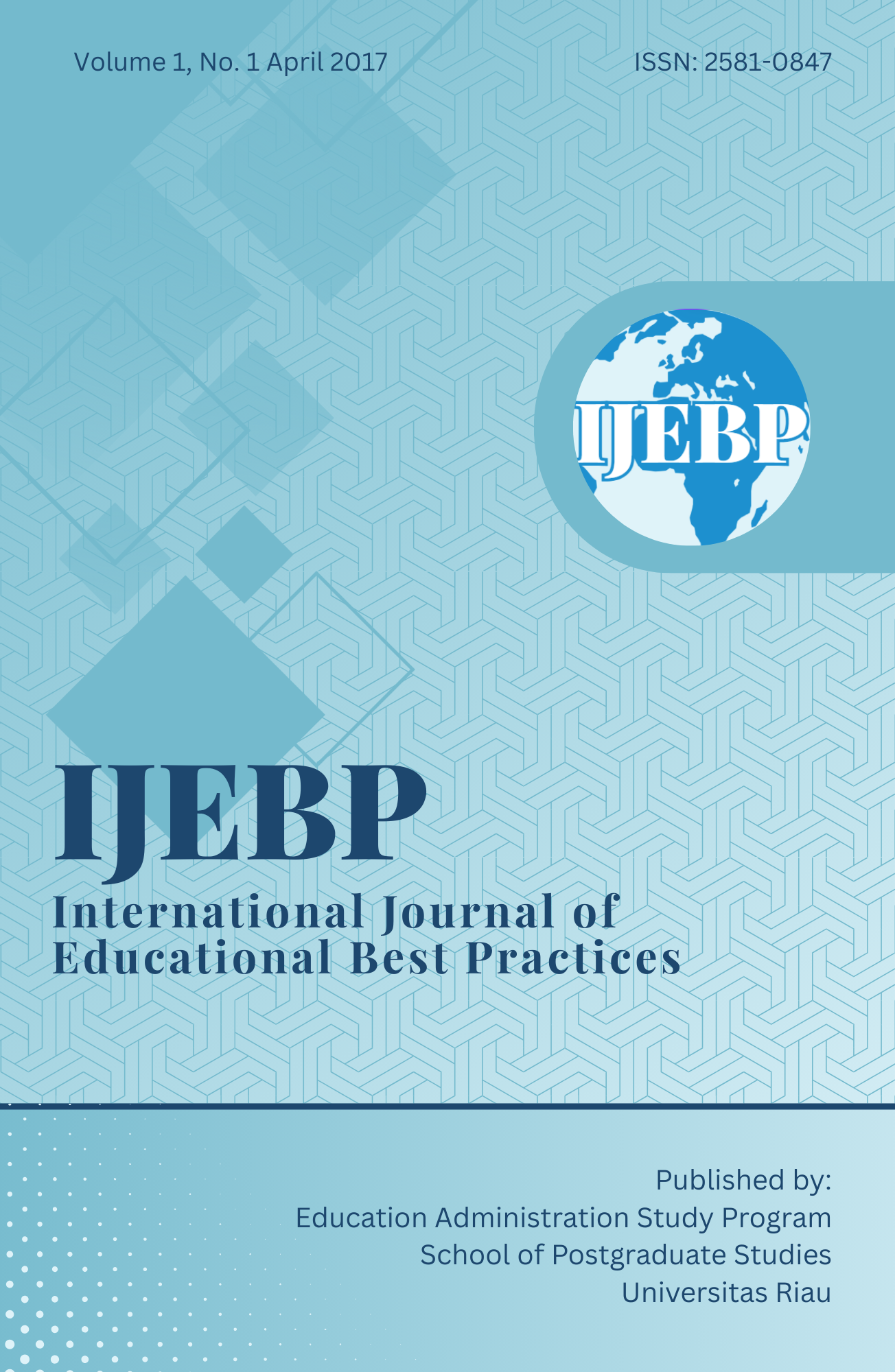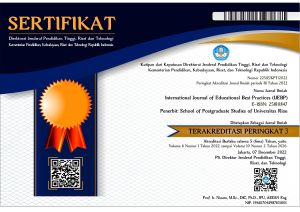An Analysis of English Proficiency of the Students of Universitas Riau – Indonesia
DOI:
https://doi.org/10.31258/ijebp.1.1.111-122Keywords:
TOEFL Equivalent, English ProficiencyAbstract
The objectives of this study are to: (1) acknowledge the students’ English competence based on the taken majors and study programs, (2) determine the general English competence (TOEFL Equivalent). The target group of the study is all students who took English language at various faculties and at the same time also enrolled at TOEFL Equivalent at UPT Bahasa Universitas Riau (Language Center). The number of the population is 9.765 the students. Due to the homogenous characters of the population, 20% out of the population (1.953 students) were taken as sample of the research. TOEFL Equivalent compiled by the Language Center of Universitas Riau was used to collect the needed data. Descriptive statistics was operated to compute the data in order to get mean of the TOEFL Equivalent scores. Inferential statistics (Annova) was applied to differentiate the scores of TOEFL Equivalent obtained by various backgrounds of the students (gender, program taken at Universitas Riau, majors at senior high schools, region of their senior high schools, school status and ethnic groups). After analysing the data, it was found that female students’ mean score is higher (405) than the male’s (402); the mean TOEFL score of the study program taken at Universitas Riau in which the English Students is the highest (432) among a lot of study programs; the mean score of the students of Riau Province is higher (420) than the Riau Archipelago Province (401); the mean score of students of private schools is higher (405) than the state schools (404); the mean of TOEFL score of Language and Art is the highest (432) among three majors (natural science, social science and other science). The last is the Chinese / Tionghoa mean of TOEFL score is the highest (438) among existing ethnic groups. The findings suggest that the students of Universitas Riau should be aware of understanding parts of the TOEFL materials like listening, reading, and structure especially in the area of their difficulties.
References
Badger, R. & White, G. (2000). A Process Gender Approach to Teaching Writing. ELT Journal, 54(2), 153-160. doi:10.1093/elt/54.2.153, http://dx.doi.org/10.1093/elt/54.2.153.
Brown, G. (2008). Selective listening. System: An International Journal of Educational Technology and Applied Linguistics, 36: 10-21.
Buck, G. (2001). Assessing listening. Cambridge: CUP. Central Bureau of Statistics. (2001). Population
Census. (2001). Kathmandu: Central Bureau of Statistics. http://dx.doi.org/10.1017/cbo9780511732959.
Celce-Murcia, M., Dörnyei, Z., & Thurrell, S. (1997). Direct approaches in L2 instruction: A turning point in Communicative Language Teaching? TESOL Quarterly, 31(1), 141-152.
Clark, Christina; & Rumbold, Kate. (2006). Reading for pleasure: A research overview. National Literacy
Trust. 5 November 2012 Retrieved from: http://www.literacytrust.org.uk/assets/0000/0562/Reading_pleasure_2006.pdf
Eamin Ali Akanda, A. K. M. (2013). 4. Reading Habit of Students in Social Sciences and Arts: A Case Study of Rajshahi University. Bangladesh
Ellis, R. (2006). Current issues in the teaching of grammar: An SLA perspective. TESOL Quarterly, 40(1), 83-106.
Doughty, C. (1991). Second language instruction does make a difference: Evidence from an empirical study of SL relativization. Studies in Second Language Acquisition, 13, 431-496.
Farrell, T. S. C. (1999). The reflective assignment: Unlocking pre-service English teachers’ beliefs on grammar teaching. RELC Journal, 30(2), 1-17.
Farrell, T. S. C., & Particia, L. P. C. (2005). Conceptions of grammar teaching: A case study of teachers’ beliefs and classroom practices. TESL-EJ, 9(2), 1-13.
Fotos, S. (1996). Integrating communicative language use and focus on form: A research agenda. In T. Fujimura, Y. Kato, M. Ahmed, & M. Leoung (Eds.), Proceedings of the 7th conference on second language research in Japan (pp. 37-41). Niigata: International University of Japan.
Field, J. (2008a). Guest editor’s introduction Emergent and divergent: A view of second language listening research. System, 36: 2–9.
Goh, C. (2008). Metacognitive instruction for second language listening development: Theory, practice and research implications. RELC Journal: A journal of language teaching and research in Southeast Asia, 39: 188-213.
Gulden Akin. (2016). Evaluation of National Foreign Language Test in Turkey. Asian Journal of Educational Research. Vol. 4, No. 3, 2016.
Hunt, R. A. (2004). Reading and writing for real: Why it matters for learning. Atlantic Universities’ Teaching Showcase, 55.
Ikpia, V. I. (2001). The attitudes and perceptions of adult English as a second language students toward explicit grammar instruction. Unpublished doctoral dissertation, New Mexico State University, Las Cruces, NM, USA.
Imai, J. (2007). Learner beliefs about isolated and integrated form-focused instruction: Japanese highschool learners of English as a second language in the United States. Unpublished doctoral dissertation,University of Toronto, Ontario, Canada
Kaoru Mita, Mika Shirao et all. (2014). The Impact of Foreign Asian Students in Japanese University EFL Classrooms. Tokyo University.
Lesesne, T. S. (1991). Developing lifetime readers: Suggestions from fifty years of research. The English Journal, 80(6), 61-64.
Mitchell, R. (2000). Applied linguistics and evidence-based classroom practice: The case of foreign language grammar pedagogy. Applied Linguistics, 21, 281-303.
Nassaji, H., & Fotos, S. (2004). Current developments in research on the teaching of grammar. Annual Review of Applied Linguistics, 24, 126-145.
Richards, J. C., Gallo, P. B., & Renandya, W. A. (2001). Exploring teachers’ beliefs and the processes of change. The PAC Journal, 1(1), 41-58.
Samineh Poorsoti and Hanieh Davatgari Asl. (2015). Iranian Candidates' Attitudes toward TOEFL iBT. Journal of Applied Linguistics and Language Researc. Volume 2, Issue 8, 2015, pp. 263-272
Satterwhite, M & Olsen, J. (2007). Business Communication at Work 3rd Ed. Newyork: McGraw Hill International Edition.
Sadoski, M., & Paivio, A. (1994). A Dual Coding View of Imagery and Verbal Processes in Reading Comprehension. In R. B. Ruddell, M. R. Ruddell & H. Singer (Eds.), Theoretical
Models and Processes of Reading, 4th Edition (pp. 582-601). Newark, DE: International Reading Association
Schulz, R. A. (2001). Cultural differences in student and teacher perceptions concerning the role of grammar teaching and corrective feedback: USA-Colombia. The Modern Language Journal, 85(2), 244-258.
Schulz, R.A. (1996). Focus on form in the foreign language classroom: Students’ and teachers’ views on error correction and the role of grammar. Foreign Language Annals, 29(3), 343-364.
Sripathum Noom-ura. (2013). English-Teaching Problems in Thailand and Thai Teachers’ Professional Development Needs. English Language Teaching; Vol. 6, No. 11; 2013 ISSN 1916-4742 E-ISSN 1916-4750 Published by Canadian Center of Science and Education 139
Tella, Adenyinka; & Akande, Samson. (2007). Children's reading habits and availability of books in Botswana primary schools: Implications for achieving quality education. The Reading Matrix, 7 (2). 10 November 2012 Retrieved from: http://www.readingmatrix.com/articles/adeyinka/article.pdf
Underwood, M. (1989): Teaching Listening. London: Longman.
Vandergrift, L. (2007). Recent developments in second and foreign language listening comprehension research. Language Teaching, 40: 191-210
Zaidoon Abdul Razaq Abboud and Nagham Ja'far Hussein. (2011). The Difficulties Faced by Advanced Iraqi Foreign Learners in Passing ITP TOEFL Test. Journal of Basrah Researches (Humanities Series) Yr.: 2011,Vol. : 36, No. : 4 :,PP. 110 -138.





